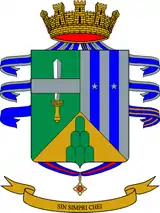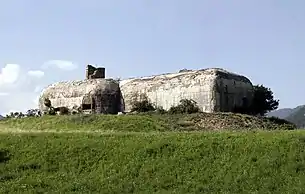Alpini Battalion "Val Tagliamento"
The Alpini Battalion "Val Tagliamento" (Italian: Battaglione Alpini "Val Tagliamento") is an inactive battalion of the Italian Army's mountain infantry speciality, the Alpini, which distinguished itself in combat during World War I and World War II.[1]
| Alpini Battalion "Val Tagliamento" | |
|---|---|
| Battaglione Alpini "Val Tagliamento" | |
 Battalion coat of arms | |
| Active | 10 February 1915 - 15 February 1918 August 1939 - July 1943 1 July 1963 - 26 September 1992 |
| Country | Italy |
| Branch | Italian Army |
| Type | Alpini |
| Part of | Alpine Brigade "Julia" |
| Garrison/HQ | Tolmezzo |
| Motto(s) | "Sin simpri chei" |
| Anniversaries | 23 April 1941 - End of the Greco-Italian War |
| Decorations | 1 × Military Order of Italy 4 × Silver Medals of Military Valour 1 × Bronze Medal of Military Valour 1 × Bronze Medal of Army Valour |
| Insignia | |
| Alpini gorget patches | |
History
World War I
The battalion was raised on 10 February 1915 with reservists of the Alpini Battalion "Tolmezzo" of the 8th Alpini Regiment. The battalion's name, like the names of all Alpini battalions raised during World War I with first line reservists, was the name of a valley near the active battalion's base; in the Val Tagliamento battalion's case the Tagliamento valley, which extends to the north from Tolmezzo. As with all Alpini battalions the recruits for the battalions were drafted exclusively from the area surrounding the battalions base. Initially the battalion fielded the 212th and 272nd Alpini companies, and received the 278th Alpini Company on 1 November 1916.[1][2]
The Val Tagliamento battalion's history is intertwined with the history of the 8th Alpini Regiment, with which it served during World War I. After having suffered heavy losses during the Battle of Caporetto and the following retreat to the Piave the battalion was disbanded on 15 February 1918. For its conduct during the war the battalion was awarded a Silver Medal of Military Valour.[1][2]
World War II
The battalion was reformed in August 1939 and assigned to the 3rd Alpine Division "Julia" 19 November 1940 for service in the Greco-Italian War. The battalion suffered heavily during the fighting in the Pindus mountains and lost its commanding officer on 8 January 1941 to enemy fire.[1] After the German invasion of Greece and the Greek surrender the battalion was sent to Yugoslavia on anti-partisan duties. For its conduct during the Greco-Italian war the battalion was awarded a Silver Medal of Military Valour. In July 1943 the battalion returned to its depot in Tolmezzo, where the battalion was renamed Alpini Battalion "Tolmezzo", as the original Tolmezzo battalion had been destroyed in Ukraine during the Italian Army in Russia's retreat in January 1943.[1]
Cold War

On 1 July 1963 the XV Alpini Fortification Battalion in Stazione Carnia was renamed Alpini Battalion "Val Tagliamento". The battalion was part of the 11th Alpini Fortification Grouping of the Alpine Brigade "Julia" and tasked with tasked to man fortifications in the upper Canale valley, which the Italian Army (correctly) assumed to be one of two main directions of a possible Warsaw Pact advance. Initially the Val Tagliamento fielded six companies, but 30 June 1964 a further three companies arrived from the disbanded Alpini Battalion "Val Natisone". During the 1975 army reform the 11th Alpini Fortification Grouping was disbanded on 1 June 1975, as was the Val Tagliamento's sister battalion "Val Fella", whose six companies were transferred to the Val Tagliamento. After the reform the Val Tagliamento received the war flag and traditions of the 11th Alpini Fortification Grouping, moved its headquarters to Tolmezzo, and fielded 16 Alpini companies for an organic strength of over 2,500 men, making it by far the largest battalion in the Italian Army. Below all companies of the battalion are listed with the Nappina color denoting to which battalion a company was originally assigned:[1]![]() = Val Tagliamento
= Val Tagliamento ![]() = Val Fella
= Val Fella ![]() = Val Natisone
= Val Natisone
 Alpini Battalion "Val Tagliamento", in Tolmezzo[3]
Alpini Battalion "Val Tagliamento", in Tolmezzo[3]
 Command and Services Company, in Tolmezzo
Command and Services Company, in Tolmezzo 212th Alpini Company (Type A*, Plöcken Pass fortifications)
212th Alpini Company (Type A*, Plöcken Pass fortifications) 216th Alpini Company (Type B*, Campiolo fortifications)
216th Alpini Company (Type B*, Campiolo fortifications) 220th Alpini Company (Type C*, Portis fortifications)
220th Alpini Company (Type C*, Portis fortifications) 269th Alpini Company (Type B, Ugovizza fortifications)
269th Alpini Company (Type B, Ugovizza fortifications) 270th Alpini Company (Type C, Malborghetto fortifications)
270th Alpini Company (Type C, Malborghetto fortifications) 271st Alpini Company (Type C, Val d'Uque fortifications)
271st Alpini Company (Type C, Val d'Uque fortifications) 272nd Alpini Company (Type C, Torre Moscarda fortifications)
272nd Alpini Company (Type C, Torre Moscarda fortifications) 273rd Alpini Company (Type C, Tratte fortifications)
273rd Alpini Company (Type C, Tratte fortifications) 278th Alpini Company (Type C, Stua di Ramaz fortifications)
278th Alpini Company (Type C, Stua di Ramaz fortifications) 288th Alpini Company (Type C, Cavazzo fortifications)
288th Alpini Company (Type C, Cavazzo fortifications) 306th Alpini Company (Type C, Sella Sompdogna fortifications)
306th Alpini Company (Type C, Sella Sompdogna fortifications) 307th Alpini Company (Type C, Sella Nevea fortifications)
307th Alpini Company (Type C, Sella Nevea fortifications) 308th Alpini Company (Type B, Sella Carnizza fortifications)
308th Alpini Company (Type B, Sella Carnizza fortifications) 312th Alpini Company (Type C, Case Marco fortifications)
312th Alpini Company (Type C, Case Marco fortifications) 313th Alpini Company (Type C, Cereschiatis fortifications)
313th Alpini Company (Type C, Cereschiatis fortifications) 314th Alpini Company (Type C, Ponte del Cristo fortifications)
314th Alpini Company (Type C, Ponte del Cristo fortifications)
- Type A = fortification fully equipped, provisioned and manned; close support platoon on site
- Type B = fortification fully equipped, provisioned and manned; close support platoon off site
- Type C = fortification fully equipped; provisions, crew and close support platoon off site
For its conduct and work after the 1976 Friuli earthquake the battalion was awarded a Bronze Medal of Army Valour, which was affixed to the battalion's war flag and added to the battalion's coat of arms.[4]
The fortifications the Val Tagliamento would man in case of war with the Warsaw Pact had been built as Alpine Wall in the early stages of World War II and as fixed fortifications became obsolete the battalion was steadily reduced in the second half of the 1980s consisted of the following companies:[1]
 Alpini Battalion "Val Tagliamento", in Tolmezzo
Alpini Battalion "Val Tagliamento", in Tolmezzo
On 26 September 1992 the battalion was disbanded its war flag was transferred to the shrine of the flags at the Vittoriano in Rome.[1]
War flag and coat of arms
Three of the medals affixed to the Val Tagliamento's war flag and displayed on the battalion's coat of arms had actually been awarded to the Val Natisone battalion (one Silver Medal of Military Valour for the battalions conduct during the Greco-Italian war and one Bronze Medal of Military Valour for the battalion's conduct during the Battle of Asiago),[5] respectively the Val Fella battalion (one Silver Medal of Military Valour for the battalions conduct during the Greco-Italian war),[6] but when the two battalions were merged into the Val Tagliamento their decorations and traditions were added to the Val Tagliamento's.
External links
Source
- Franco dell'Uomo, R. di Rosa: "L'Esercito Italiano verso il 2000 - Volume Secondo - Tomo I", Rome 2001, Stato Maggiore dell'Esercito - Ufficio Storico, page: 500
References
- "Battaglione Alpini Val Tagliamento". vecio.it. Retrieved 7 December 2019.
- "Val Tagliamento". Fronte del Piave. Retrieved 6 December 2019.
- F. dell'Uomo, R. di Rosa (2001). L'Esercito Italiano verso il 2000 - Vol. Secondo - Tomo I. Rome: SME - Ufficio Storico. p. 500.
- "Battaglione Alpini "Val Tagliamento"". Quirinale - Presidenza della Repubblica. Retrieved 8 December 2019.
- "Battaglione Alpini Val Natisone". vecio.it. Retrieved 8 December 2019.
- "Battaglione Alpini Val Fella". vecio.it. Retrieved 8 December 2019.